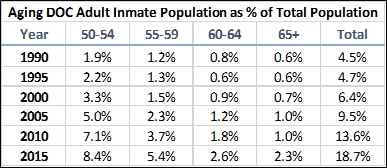Jails for the Sick and Elderly
19% of state prisoners now over age 50, up from 5% in 1995.
![Columbia Correctional Institution. Photo by Dual Freq (Own work) [CC BY-SA 3.0 (http://creativecommons.org/licenses/by-sa/3.0) or GFDL (http://www.gnu.org/copyleft/fdl.html)], via Wikimedia Commons.](https://urbanmilwaukee.com/wp-content/uploads/2016/08/Columbia_Correctional_Institution_Wisconsin_with_guard_tower.jpg)
Columbia Correctional Institution. Photo by Dual Freq (Own work) [CC BY-SA 3.0 (http://creativecommons.org/licenses/by-sa/3.0) or GFDL (http://www.gnu.org/copyleft/fdl.html)], via Wikimedia Commons.
In 2014, three inmates were granted compassionate release. In 2015, the figure was four, and in 2016 through November, two.
The criteria DOC uses for determining who might get under compassionate release is not clear to outsiders, said David Liners, state director of WISDOM, a leading prison reform advocacy group..
“It’s frankly, it’s a mystery to us, like so many things in the Department of Corrections. …They don’t seem to give the reasons and – we’re as mystified as anybody. It seems their criteria are incredibly tight.”
Inmates serving sentences for the most serious crimes – Class A or B felonies with maximum sentences of 60 years or more – do not qualify for compassionate release, according to DOC policy. Other inmates seeking compassionate release must be at least 65 or older and have served at least five years in prison or be 60 or older and have served at least 10 years in prison on each count, or have an extraordinary health condition.
Applying inmates must complete multiple forms and those claiming an extraordinary health condition, defined as a having a need for medical treatment or services not available within a correctional facility, must supply affidavits from two physicians, including a DOC doctor.
That paperwork requirement is a non-starter for many inmates who could benefit from compassionate release, Liners said.
“The people most in need of compassionate release are probably the people least likely able to be able to take the initiative to find out all the rules and to comply with all the paperwork,” he said.
“It’s incredibly expensive and wasteful for us to be putting all these resources to keep people in that setting when in so many cases their families are willing to take them in. There’s nursing homes willing to take them in that would be a lot less expensive,” Liners said.
The state prisons already are beyond their capacity, figures show. There were 9,116 new admissions to Wisconsin prisons last year, the most since 2009, when the state admitted 9,445 adults to its prison population. The total adult prison population was 22,903 as of Feb. 24 and Gov. Scott Walker‘s proposed budget projects the average daily prison population will rise to 23,330 in 2017-18 and 23,233 in 2018-19. He is requesting a $50 million increase in the 2017-19 Department of Corrections budget, according to the Legislative Fiscal Bureau.
“Even where the prison populations are declining, the budgets aren’t, because the aging prisoner population is so much more expensive,” Liners said.
Meanwhile, a 93-year-old man is sitting in prison, and so is an 83-year-old woman, according to Department of Corrections figures. The share of the prison population that is at least 50 years old was 18.7 percent in 2015, up from 4.5 percent in 1990.
A 2016 DOC report shows that the two-year recidivism rate for released inmates aged 60 or over was just just 5.2 percent.
“The reason that we have for incarcerating people is primarily to protect the public,” Liners said. “And these are people who are not a danger in any way, shape or form to the public. Just for the sake of being a little more punitive and keeping somebody who is elderly or ill in prison for their remaining days just seems vindictive, it doesn’t seem like justice. It just seems like overkill.”
Gretchen Schuldt writes a blog for Wisconsin Justice Initiative, whose mission is “To improve the quality of justice in Wisconsin by educating the public about legal issues and encouraging civic engagement in and debate about the judicial system and its operation.”






















